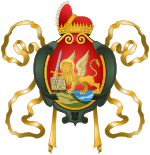Marino Sanuto the Younger
- There is also a Marino Sanuto the Elder.
Marin Sanudo, italianised in Marino Sanuto or Sanuto the Younger (May 22, 1466 – 1536) was a Venetian historian.

He was the son of the senator Leonardo Sanuto. Left an orphan at the age of ten, he lost his fortune owing to the bad management of his guardian, and was for many years hampered by want of means. In 1483 he accompanied his cousin Mario, who was one of the three sindici inquisitori deputed to hear appeals from the decisions of the rettori, on a tour through Istria and the mainland provinces, and he wrote a minute account of his experiences in his diary.

Wherever he went he sought out learned men, examined libraries, and copied inscriptions. The result of this journey was the publication of his Itinerario per la terraferma veneziana and a collection of Latin inscriptions. Sanuto was elected a member of the Maggior Consiglio when only twenty years old (the legal age was twenty-five) solely on account of his merit, and he became a senator in 1498; he noted down everything that was said and done in those assemblies and obtained permission to examine the secret archives of the state. He collected a fine library, which was especially rich in manuscripts and chronicles both Venetian and foreign, including the famous Altino chronicle, the basis of early Venetian history, and became the friend of all the learned men of the day, Aldo Manuzio dedicating to him his editions of the works of Angelo Poliziano and of the poems of Ovid. It was a great grief to Sanuto when Andrea Navagero was appointed the official historian to continue the history of the republic from the point where Marco Antonio Sabellico left off, and a still greater mortification when, Navagero having died in 1529 without executing his task, Pietro Bembo was appointed to succeed him. Finally in 1531 the value of his work was recognized by the senate, which granted him a pension of 150 gold ducats per annum. He died in 1536.
His chief works are the following: Itinerario per la terraferma veneziana, published by M. Rawdon Brown in 1847; I commentari delta guerra di Ferrara, an account of the war between the Venetians and Ercole I d' Este, published in Venice in 1829; La Spedizione di Carlo VIII.(MS. in the Louvre); Le Vite dei Dogi, published in vol. xxii. of Muratori's Rerum Italicarum Scriptores (1733); the Diarii, his most important work, which cover the period from 1 January 1496 to September 1533, and fill 58 volumes. The publication of these records was begun by Rinaldo Fulin in 1879, in collaboration with Federigo Stefani, Guglielmo Berchet, and Niccold Barozzi; the last volume was published in Venice in 1903. Owing to the relations of the Venetian republic with the whole of Europe and the East it is practically a universal chronicle, and is an invaluable source of information for all writers on that period.
Sanuto played a role in placing the Venetian Jews in the first ever Jewish ghetto, as he stated in a speech in 1515, a year before the ghetto's establishment: "I do not want to omit to relate an evil practice resulting with the continuing contact with these Jews, who reside in great numbers in the cities. Formerly, they were not seen outside their houses from palm Sunday until after Easter. Now till yesterday they were going about and it is a very bad thing, and no one says anything to them, since we need them due to the wars and therefore do what they want."
References
 This article incorporates text from a publication now in the public domain: Chisholm, Hugh, ed. (1911). Encyclopædia Britannica (11th ed.). Cambridge University Press.
This article incorporates text from a publication now in the public domain: Chisholm, Hugh, ed. (1911). Encyclopædia Britannica (11th ed.). Cambridge University Press.
| Wikisource has original text related to this article: |
|